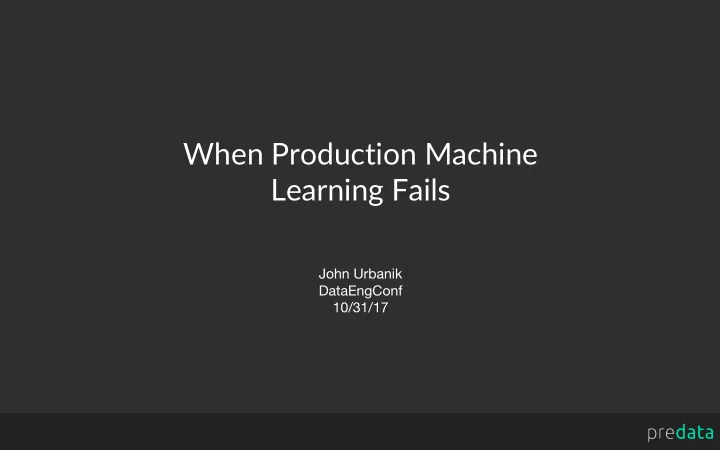

When Production Machine Learning Fails John Urbanik DataEngConf 10/31/17
OR: When initially promising seeming supervised learning models don't quite make it to production, or fail shortly after being productionized, why? How can we avoid these failure modes?
Media Coverage of AI/ML Failure 3
A Framework 1. A survey of some less discussed Class Imbalance • Time based effects failure modes • latent time dependence 2. Techniques for detecting and/or • solving them • concept drift • Non-stationarity Structural breaks • Business applicability • Dataset availability, • • Look-ahead bias • Metrics and loss functions 4
Predata Data Our data exhibits all sorts of non- stationarity, is extreme value distributed, have many structural breaks. Our prediction targets are heavily imbalanced and exhibit multiple modes of concept drift. 5
Things Not Covered • Conventional overfitting Interpretability • Most commonly raised obstacle, often used to help with model selection • Lack of data • In some cases this is solvable with money or time • • Also see Claudia's talk titled "All The Data and Still Not Enough” Dirty, noisy, missing, or mislabeled data • Refer to Sanjay’s talk yesterday • Problems without ‘straightforward’ solutions (i.e. censored data, unsupervised learning • and RL) 6
Class Imbalance • Classical examples: cancer • MSE / Accuracy derived metrics detection, credit card fraud don't work well ROC, Cohen's Kappa, macro- • Predata examples: terrorist averaged recall better, but not the • incidents, large scale civil protests end all 7
Class Imbalance (cont’d) 1. Oversampling, undersampling 2. Adjust class / sample weights 3. Frame as anomaly detection problem (only in two class case) 4. SMOTE and derivatives - ADASYN and other variants Check out imbalanced-learn https://svds.com/learning-imbalanced-classes/ 8
Latent Time Dependence • Don't JUST use K-Fold cross validation Also use a set of time oriented test/train splits • Some time series splits are ‘lucky’ or ‘easy,’ especially in the presence of • concept drift and class imbalance Plot performance metrics via a sliding window over time in holdout • https://svds.com/learning-imbalanced-classes/ 9
Non-stationarity • Seasonality / weak stationarity seasonal adjustment • feature engineering • Trend stationary • Growth (exponential or additive) • • KPSS test Model the trend, remove it • Rolling z-score • Difference stationary • ADF unit root test • • Use differencing to remove Beware fractional integration - • long memory (GPH test) http://www.simafore.com/blog/bid/205420/Time-series-forecasting-understanding- 10 trend-and-seasonality
Structural Breaks • Unexpected shift, often caused by exogenous events Change detection is a very active area of research • Chow test for single change-point • Multiple breaks require tests like sup-Wald/LM/MZ • These make assumptions like homoskedasticity • • Mitigate by using just recent data https://en.wikipedia.org/wiki/Structural_break#/media/ https://www.stata.com/features/overview/structural-breaks/ File:Chow_test_example.png 11
Concept Drift Changing relationship between independent and dependent variables OR Changing class balance / Mutating nature of classes Active and passive solutions: • • Active rely on change detection tests / online change detection Passive solutions continuously update the model • There is active research in ensembling based on time based performance • Predata is particularly interested in resurfacing old successful classifiers • after some transient change / exogenous shock 12
Other Time Series Effects • Volatility clustering Poisson/Cox/Hawkes processes • Random walks / Wiener processes • Volatility Clustering Phenomenon of Financial Time Series Source: Alexander, C. (2001) https://stackoverflow.com/questions/24785518/how-to- https://github.com/matthewfieger/wiener_process compute-residuals-of-a-point-process-in-python 13
Look-Ahead Bias and Time Delays • Make sure that you have guarantees (or mitigation strategies) if you have data availability failures Ensemble models with different delays • Surface data outages to data consumers • Feature engineering done now might not have been intuitive in the past. If there is • concept drift, how can we be sure that performance will continue. Look at performance over time in live test • Automated feature engineering / feature selection • Use judgement; use features that seem like they would be stable across time (little • concept drift) or features that would likely be discovered in real time 14
Loss Functions and Metrics • How does you business value Type I/II errors? Time series prediction specific: • Is an early prediction useful? • Should a late prediction be penalized fully? • How do we weight samples based on their importance? • • How do you translate business concerns to the optimization / modeling layer Writing custom loss functions • AutoGrad, PGM like Edward • Genetic algorithms • 15
Questions? John Urbanik jurbanik@predata.com @johnurbanik 16
Recommend
More recommend